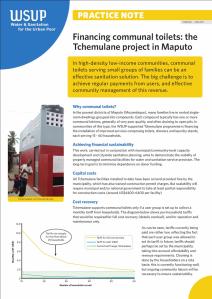Women and girls in Nairobi’s slums live under the constant threat of sexual violence, leaving them often too scared to leave their houses to use communal toilet and bathroom facilities, Amnesty International said in a new report released on 7 July 2010.
Amnesty International calls on the Kenyan government to enforce landlords’ obligations to construct toilets and bathrooms in the slums and settlements and provide assistance to structure owners who are unable to meet the costs of constructing toilets and bathrooms.
 Insecurity and Indignity: Women’s experiences in the slums of Nairobi, Kenya [1] details how the failure of the government to incorporate the slums in urban plans and budgets has resulted in poor access to services like sanitation, which hits women in slums and informal settlements especially hard.
Insecurity and Indignity: Women’s experiences in the slums of Nairobi, Kenya [1] details how the failure of the government to incorporate the slums in urban plans and budgets has resulted in poor access to services like sanitation, which hits women in slums and informal settlements especially hard.
“Women in Nairobi’s settlements become prisoners in their own homes at night and some times well before it is dark,” said Godfrey Odongo, Amnesty Internationals East Africa researcher. “They need more privacy than men when going to the toilet or taking a bath and the inaccessibility of facilities make women vulnerable to rape, leaving them trapped in their own homes.
“The fact that they are unable to access even the limited communal toilet facilities also puts them at risk of illness.”
The situation is compounded by the lack of police presence in the slums and when women fall victim to violence they are unlikely to see justice done. Kibera, Nairobi’s largest slum and home to up to a million people, has no police post.
“I always underestimated the threat of violence,” said 19-year-old Amina of Mathare slum. “I would go to the latrine any time provided it was not too late. This was until about two months ago when I almost became a victim of rape.”
Amina was set upon by a group of four men while she walked to the latrine at 7pm. They hit her, undressed her and were about to rape her when her cries were heard and a group of residents came to save her. Although she knew one of the men involved in the assault, Amina did not go to the police as she feared reprisal attacks.
Unable to leave their one-roomed houses after dark, many women in informal settlements resort to ‘flying toilets’ – using plastic bags thrown from the home to dispose of waste.
Women also told Amnesty International how the poor sanitary conditions they live in – which include widespread disposal of human excreta in the open because of lack of adequate access to toilets – directly contribute to cases of poor health and to high health care costs.
Other women describe the humiliation of bathing in front of their relatives and children.
Even by day, public bathroom facilities are few and far between and invariably involve walking long distances. According to official figures, only 24 per cent of residents in Nairobi’s informal settlements have access to toilet facilities at household level.
Despite some positive features, Kenya’s Millennium Development Goal (MDG) policies to meet the target on sanitation do not address the specific needs of women who face the threat of violence because they lack adequate sanitation.
They also do not address the lack of enforcement of regulations requiring owners and landlords to provide sanitation.
“There is a huge gap between what the government commits to do, and what is going on in the slums everyday” said Godfrey Odongo.
“Kenya’s national policies recognise the rights to sanitation and there are laws and standards in place. However, because of decades of failure to recognize slums and informal settlements, planning laws and regulations are not enforced in these areas.
“The lack of enforcement of these laws has ensured that landlords and structure owners in the slums can get away without providing any toilets or shower places for their tenants”
Lack of security of tenure also remains a long standing problem for tenants, despite a national land policy in place, removing any incentives that landlords or owners could have to ensure proper sanitation, and measures to increase security.
Amnesty says the government must also take immediate measures to improve security, lighting and policing and ensure that relevant government authorities coordinate their efforts to improve the water and sanitation situation in the settlements.
Amnesty representatives met with officials from the Ministry of Health, the City Council including the Town Clerk, and also some officials from the official regulator of water and sanitation services within Nairobi, the Athi Water Services Board.
In almost all of the meetings, it was agreed that there was little coordination between the relevant Ministries in the government to ensure that women in slums had access to water and sanitation.
Even though Amnesty recognised that the situation is complicated, representatives stressed that this is no reason to pass the buck from one Ministry to the next.
Some of the officials committed to asking the Office of the Prime Minister to bring together all of the relevant officials in an attempt to ensure that water and sanitation is provided for women in slums.
[1] Amnesty International (2010). Insecurity and indignity : women’s experiences in the slums of Nairobi, Kenya. London, UK, Amnesty International Publications. Download full report
The report is one of the outputs of Amnesty International’s Demand Dignity campaign
Source: Amnesty International, 07 Jul 2010 ; Amy Agnew, Livewire, 07 Jul 2010









